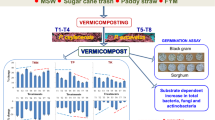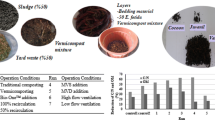Abstract
Efforts were made to recycle sugar industry waste ‘press mud’ (PM) with an objective to ascertain the water-holding capacities with monoculture vermireactor systems using Eisenia fetida (MVR1); Eudrilus eugeniae (MVR2); Megascolex megascolex (MVR3); and polyculture vermireactor systems using Eisenia fetida + Eudrilus eugeniae (PVR1); Eisenia fetida + Megascolex megascolex (PVR2); Eudrilus eugeniae + Megascolex megascolex (PVR3). The vermicompost harvested after 40 days was subjected to a standard Proctor compaction test by using 3 kg industry soil and 200 g of vermicompost for each cycle of compaction up to seven cycles. The least dry density and highest water content 0.6, 170%; 0.66, 170%; 0.71, 170% and 0.52, 210%; 0.51, 180%; 0.71, 150% for vermicomposts of MVR3, MVR2, MVR1 and PVR3, PVR2, PVR1, respectively. The monoculture reactor using Megascolex megascolex can hold 110–170% and polyculture vermireactor using indigenous Megascolex megascolex + Eudrilus eugeniae (PVR3) can hold 140–210% of water under experimental conditions. The species Megascolex megascolex used individually and in combinations with Eudrilus eugeniae are best suited for biodegradation of press mud, and composts derived are having increase water-holding capacities. The addition of VC to the soil increases water-holding capacity and by maintaining evaporation losses to minimum as good adsorbent of atmospheric moisture eventually helps in maintaining the ecology of hydrologic cycle. Increasing water-holding capacity is one of the soil erosion control measures that influences soil productivity in both managed and natural ecosystems.


Similar content being viewed by others
Abbreviations
- MVR1:
-
Eisenia fetida
- MVR2:
-
Eudrilus eugeniae
- MVR3:
-
Megascolex megascolex
- PVR1:
-
Eisenia fetida + Eudrilus eugeniae
- PVR2:
-
Eisenia fetida + Megascolex megascolex
- PVR3:
-
Eudrilus eugeniae + Megascolex megascolex
- VC:
-
Vermicompost
- PM:
-
Press mud
References
Asawa GL (1996) Irrigation engineering, vol Second. New Age International Pvt. Ltd., New Delhi, pp 45–48
Bhandari GS, Randhwa MS, Naskina MS (1967) Polysaccharide content of earthworm cast. Curr Sci 36:519–520
Bhawalkar V, Bhawalkar U (1992) Vermiculture biotechnology. Bhawalkar Earthworm Research Institute, Pune, pp 1–60
Chan KY, Heena DP (1995) Occurrence of enchytraed worms and some properties of their casts in Australian soil under cropping. Aust J Soil Res 33:651–657
Edwards CA, Bohlen PJ (1996) Biology and ecology of earthworms. Chapman and Hall, London, pp 35–55
Edwards CA, Lofty RE (1977) Biology of earthworms. Chapman and Hill, London, pp 129–147
Flankenmark M (1989) Water scarcity and food production. In: Piemental D, Hall CW (eds) Food and natural resources. Academic Press, San Diego, pp 164–191
Ghatenkar SD, Kavian M, Ghatnekar G (1995) Biomanagement of waste through vermiculture. Ecology 10:1–7
Ghildyal BP, Gupta RP (2002) Soil structure problems and management. ICAR, New Delhi, pp 1–55
Giraddi RS, Kitturmath MS (2002) Biodegradation of some industrial wastes using Eudrilus eugeniae A MSc Thesis. Sub UAS Dharwad, pp 6–20
Hamilton WE, Dindal DL (1989) Influence of earthworms and leaf litter on edaphic variables in sewage sludge treated soil microcosmos. Biol Fertil Soils 7:129–133
Jackson ML (1973) Soil chemical analysis. Prentice Hall of India Pvt. Ltd., pp 1–226
Kale RD (1994) Vermicomposting of waste materials: earthworm cinderella of organic farming. Prism Book Pvt. Ltd., New Delhi, India, pp 47–57
Kale RD, Ban K, Sreenivas MN, Bhagaraj DJ (1987) Influence of wormcast on the growth and mycrorrhizall colonization of two ornamental plants. South Indian Hortic 35:433–437
Kannan N (1996) Laboratory Manual in General Microbiology. Palani Paramount Pub Palani, India, pp 30–90
Lal R, Stewart BA (1990) Soil degradation, a global threat. In: Lal R, Stewart BA (eds) Advances in soil science, vol II. Springer, Berlin, pp 13–17
Lambe TW (1953) The structure of inorganic soils. Proc Am Soc Civil Eng 79(315):49
Mahajan BB (2004) Methods in biostatistics. Japee Brothers Medical Pub Pvt Ltd., New Delhi, pp 130–156
Modi PN (1995) Irrigation water resource and water power engineering. Standard Book House, New Delhi, pp 63–67
Munnoli PM (2007) Management of industrial organic solid wastes through vermiculture biotechnology with special reference to microorganisms. PhD thesis, Goa University, India, pp 1–334
Munnoli PM, Bhosle S (2007) Vermicomposting a clean technology for the treatment of press mud: A case study of Sanjeevani co operative sugar factory Dayanand Nagar Goa. In: Sundermoorthy S, Saravanane R, Sivasankaran MA, Srinivasan G (eds) Proceedings of international conference on cleaner technologies and environmental management, Organized by Pondicherry Engineering College Puducheri, Allied Publishers Pvt. Ltd., New Delhi, India, pp 247–253
Munnoli PM, Bhosle S (2008a) Sustainable industrial development through microbial technology, In: 23rd National convention of environmental engineers. environmental economics and clean technologies, Organized by institution of engineers india 12–13th January 2008, Anupama Press, Ranchi, pp 49–63
Munnoli PM, Bhosle S (2008b) Soil aggregation by vermicompost of press mud. Curr Sci 95(11):1533–1535
Munnoli PM, Bhosle S (2009) Effect of soil cow dung proportion of vermi-composting. J Sci Ind Res 68:57–60
Munnoli PM, Shivapur AV (2004) Vermiculture: a self help technology for the rural development. In: Proceedings of national seminar on ground water management and rural development, Anjumen Engineering College, NAAZ Printing Press, Bhatkal, pp 168–170
Munnoli PM, Arora JK, Sharma SK (2000) Organic waste management through vermiculture: a case study of Pepsi Foods Ltd., Punjab. In: Jana BB, Banarjee RD, Guterstam B, Heeb J (eds) Waste resource recycling in the developing world. Swapna Printing Works Pvt. Ltd., Kolkotta, pp 203–208
Munnoli PM, Arora JK, Sharma SK (2002a) Impact of vermi processing on soil characteristics. J Ind Pollut Control 18(1):87–92
Munnoli PM, Arora JK, Sharma SK (2002b) Mining waste land development. Int J Ecol Environ Conserv 8(4):373–375
Munnoli PM, Arora JK, Sharma SK (2002b) Utilization of solid waste in sugar industry, Industry and Environment; Proceedings of national conferences. Daya Pub House, pp 424–427
Pagaria P, Totwat KL (2007) Effects of press mud and spent wash in integration with spent wash with phosphogypsum on metallic cation build up in the calcareous sodic soils. J Ind Soc Soil Sci 55(1):52–57
Piccone G, Biosoil B, Deluca G, Minelli L (1986) Vermicomposting of different organic wastes. In: Compost production and use symposium, 17–19, April 1986, Udine, Italy, pp 818–821
Pimentel D, Harvey C, Resosudarmo P, Sinclair K, Kruz D, Mc Nair M, Crist S, Sphpritz L, Fitton L, Saffouri R, Blair R (1995) Environmental and economic costs of soil erosion and conservation benefits. Science 267:1117–1123
Pumnia BC (2001) Soil mechanics and foundation engineering. Standard Book House, New Delhi, pp 1–121
Pumnia BC (2002) Soil mechanics and foundation engineering, 13th edn. Standard Book House, New Delhi, 300 pp
Sangawan P, Kaushik CP, Garg VK (2008) Feasibility of utilization of horse dung spiked filter cakes in vermicomposters using exotic earthworm Eisenia fetida for recycling of nutrients. Bioresour Technol 99(7):2442–2448
Sharma SK (2002) Application of vermiculture in the management of municipal waste and agro residues. In: Proc of Nal Sem on Solid Waste Management, Bangalore University, 13–14 Dec 2002. pp 112–114
Singh NB (1997) Development of process package for organic solid waste management through vermiculture biotechnology in organic waste generating industries in Punjab’. ME Thesis, TIET Deemed University Patiala, Punjab, pp. 91–93
Stockdill SJ, Cossens GG (1966) The role of earthworms in pasture production and moisture conservation. In: Proceedings of Newzeland Grassland Association, vol 1 pp 68–83
Suthar S (2006) Potential utilization of gaur gum industrial waste in vermicomposting production. Bioresour Technol 7:2474–2477
Suthar S (2007) Production of vermifertilizer from gaur gum industrial wastes by using composting earthworm Perionyx sansibaricus (Perrier). Environmentalist 27:329–335
Suthar S (2008a) Development of a novel epigeic-anecic-based polyculture vermireactor for efficient treatment of municipal sewage water sludge. Int J Environ Waste Manag 2(1/2):84–101
Suthar S (2008b) Microbial and decomposition efficiencies of monoculture and polyculture vermireactors, based on epigeic and anecic earthworms. World J Microb Biotechnol 24:1471–1479
Suthar S, Singh S (2008) Comparison of some novel polyculture and monoculture vermi-composting reactors to decompose organic wastes. Ecol Eng 33(3–4):210–219
Trivedy RK, Thomas Sonia (2002) Earthworm biotechnology for waste management and crop improvement: a review of research In: Somashekhar RK, Iyengar MAR (eds) Proceedings of national seminar on solid waste management. Allied Publishers Pvt. Ltd., New Delhi, pp 120–123
Acknowledgments
We thank Prof. Sunila Mavinkurve for her support and encouragement. The funding received from CAPART is thankfully acknowledged.
Author information
Authors and Affiliations
Corresponding author
Rights and permissions
About this article
Cite this article
Munnoli, P.M., Bhosle, S. Water-holding capacity of earthworms’ vermicompost made of sugar industry waste (press mud) in mono- and polyculture vermireactors. Environmentalist 31, 394–400 (2011). https://doi.org/10.1007/s10669-011-9353-6
Published:
Issue Date:
DOI: https://doi.org/10.1007/s10669-011-9353-6




